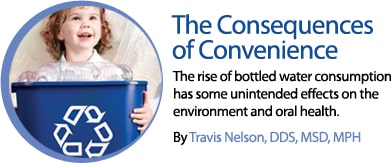
The Consequences of Convenience
The rise of bottled water consumption has some unintended effects on the environment and oral health.
The use of bottled water in the United States has increased dramatically over the past several years. In 2007, the average annual rate of consumption was 29 gallons per person—more than double 1997’s average of 13.5 gallons.1 Bottled water is now the nation’s second most popular beverage following commercial soft drinks.2 Those who prefer to drink bottled water over tap water do so for reasons of taste, convenience, and fear of contaminants.3 These advantages have fueled its popularity, but the rise of bottled water use does have consequences.
Bottled water is marketed as pure and natural, however it is actually less regulated than municipal water, so bottled water devotees probably do not know what they are ingesting.4 Additionally, consumption of bottled water has major economic and environmental implications. Approximately 70% of plastic water bottles are not recycled, and thus end up in landfills or polluting the landscape. The energy and transportation costs associated with bottled water production and distribution are also significant. Bottled water costs roughly the same amount as gasoline, and is 1,000 times to 5,000 times more expensive than tap water.5 There may be oral health consequences, as well. Today many dental patients derive most of their fluid intake from bottled sources. As a result, dental professionals need to understand any relevant effects on oral health so they can provide appropriate recommendations to their patients.
Fluoride in Public Water
Fluoride was first incorporated into public drinking water supplies in 1945. Shortly thereafter, the US began experiencing a significant decline in prevalence and severity of dental caries, which is attributed largely to water fluoridation. Indeed, public water fluoridation has been so successful at preventing disease that the US Centers for Disease Control and Prevention has called it one of the 10 great public health achievements of the 20th century.6 The Environmental Protection Agency (EPA) is responsible for regulating public water fluoridation at the federal level, and recently reduced the recommended water fluoride levels to 0.7 parts per million (PPM).7
Fluoride in Bottled Water
In contrast to public water supplies, bottled water is regulated by the US Food and Drug Administration (FDA). The FDA’s standard of quality regulations generally mirror those of the EPA, however the FDA does not require display of bottled water’s fluoride concentration on the label.4 In fact, one study found that of 65 bottled water brands, only 5% listed fluoride content on their labels and 80% contained a suboptimal level of fluoride.8 A large degree of variability often exists between differing batches of the same brand of water.8,9 This is largely because the content of commercially available water products differs greatly—from water bottled with municipal sources to water that is purified using sophisticated industrial processes. Reverse osmosis or distillation processes remove fluoride from water, however charcoal/carbon filters (present in the majority of commercially-available home filtration systems) do not.10 Table 1 contains the fluoride content of many popular brands of bottled water.8
Effects on Caries Experiences
In contrast to professional fluoride treatments, such as prescription-strength toothpaste and fluoride varnish, fluoridated water is recommended for all patients.11 This is because communities with fluoridated water continue to experience significantly less caries with few adverse effects.12 One systematic review investigated the effect of removing fluoridation from public water supplies and found an 18% median increase in dental caries among children aged 6 years to 10 years after fluoride was removed.13 Similarly, because bottled water usually does not contain the recommended levels of fluoride, patients who drink it may not be receiving the same anti-caries benefit as those who consume tap water.
Although there is some concern that bottled water consumption may be affecting oral health, a direct association between bottled water consumption and caries has not been shown. To date, very little research has investigated this specific question. One study, however, did evaluate caries experience in children aged 7 years to 12 years who consumed varying levels of bottled water (almost all water intake, about half of total water consumption, and little consumption). As expected, those participants who were classified as “bottled water users” had a significantly lower calculated daily fluoride intake. In this study, permanent tooth caries among bottled water users was slightly more prevalent, although this finding was not statistically significant. This was due in part to the low number of subjects who consumed high levels of bottled water. Additionally, to be classified as “users” subjects must have consumed more than 25% of their water from a bottled source. As such, it is possible that they were still exposed to significant amounts of fluoride from municipal water sources. Although this study was not conclusive, caries experience may be higher in populations who consume a significant portion of their water from bottled sources.14
Practitioners should also consider that bottled water consumption may vary by region. A recent study found that 69% of children living in one New York community consumed some bottled water. Approximately one-third of this group consumed bottled water as their only water source. Although this urban sample showed a high percentage of exclusive users, not all communities do. For example, only 9% of children in a Colorado sample selected bottled water as their preferred source.3 Consumption may also differ according to socioeconomic and cultural variables. Another study reported that low-income and Latino families were more likely to use bottled water due to concerns over illness that could be acquired from public water.15 These findings are important because both groups are already at elevated caries risk.
Recommendations for the Practitioner
There is a clear upward trend in the consumption of bottled water products, which contain lower levels of fluoride than is currently recommended. Though not firmly established, this may increase the caries risk of our patients. Therefore, dental practitioners should consider a patient’s source of water when evaluating caries risk. For those patients who are at high caries risk and consume a large percentage of water from bottled sources, it may be prudent to determine the fluoride content of the water they drink most frequently. This can be done with a low-cost water test kit that has received the American Dental Association Seal of Acceptance (such as FluoriCheck™ by 3M ESPE)16 or by contacting the water manufacturer.8 If the water consumed by patients at high caries risk has fluoride levels below the recommended level, alternative sources, such as prescription-strength toothpaste or professional fluoride treatments, may be indicated.
By taking into account the types and quantities of water our patients drink, we can provide the best recommendations for optimal oral health.
REFERENCES
- Rodwan JGJ. Confronting challenges: US and international bottled water developments and statistics for 2008. Bottled Water Reporter. Available at: http://bottledwater.org/public/stats_2007.doc. Accessed January 23, 2012.
- National Resources Defense Council. Bottled Water: Pure drink or pure hype? Available at: www.nrdc.org/water/drinking/bw/chap2.asp. Accessed January 23, 2012.
- Sriraman NK, Patrick PA, Hutton K, Edwards KS. Children’s drinking water: parental preferences and implications for fluoride exposure. Pediatr Dent. 2009;31:310-315.
- Office United States Government Accountability Office. Bottled Water. FDA safety and consumer protections are often less stringent than comparable EPA protections for tap water. Available at: http://wren.palwv.org/library/documents/GAOBottledwater.pdf. Accessed January 23, 2012.
- Huerta-Saenz L, Irigoyen M, Benavides J, Mendoza M. Tap or bottled water: drinking preferences among urban minority children and adolescents. J Community Health. 2012;37:54-58.
- Centers for Disease Control and Prevention. Ten great public health achievements—United States, 2001-2010. MMWR Morb Mortal Wkly Rep. 2011;60:619-623.
- United States Department of Health and Human Services. HHS and EPA announce new scientific assessments and actions on fluoride: January 7, 2011. Available at: www.hhs.gov/news/press/2011pres/01/20110107a.html. Accessed January 23, 2012.
- Johnson SA, DeBiase C. Concentration levels of fluoride in bottled drinking water. J Dent Hyg. 2003;77:161-167
- Weinberger SJ. Bottled drinking waters: are the fluoride concentrations shown on the labels accurate? Int J Paediatr Dent. 1991;1:143-146.
- Jobson MD, Grimm SE, Banks K, Henley G. The effects of water filtration systems on fluoride: Washington, DC metropolitan area. ASDC J Dent Child. 2000;67:350-354.
- Horowitz HS. The 2001 CDC recommendations for using fluoride to prevent and control dental caries in the United States. J Public Health Dent. 2003;63:3-10.
- Newbrun E. What we know and do not know about fluoride. J Public Health Dent. 2010;70:227-233.
- Truman BI, Gooch BF, Sulemana I, et al. Reviews of evidence on interventions to prevent dental caries, oral and pharyngeal cancers, and sports-related craniofacial injuries. Am J Prev Med. 2002;23(Suppl):21-54.
- Broffitt B, Levy SM, Warren JJ, Cavanaugh JE. An investigation of bottled water use and caries in the mixed dentition. J Public Health Dent. 2007;67:151-158.
- Hobson WL, Knochel ML, Byington CL, et al. Bottled, filtered, and tap water use in Latino and non-Latino children. Arch Pediatr Adolesc Med. 2007;161:457-461.
- Dental product spotlight: fluoride analysis kit. J Am Dent Assoc. 2003;143:336.
From Dimensions of Dental Hygiene. February 2012; 10(2): 30-32, 34.


